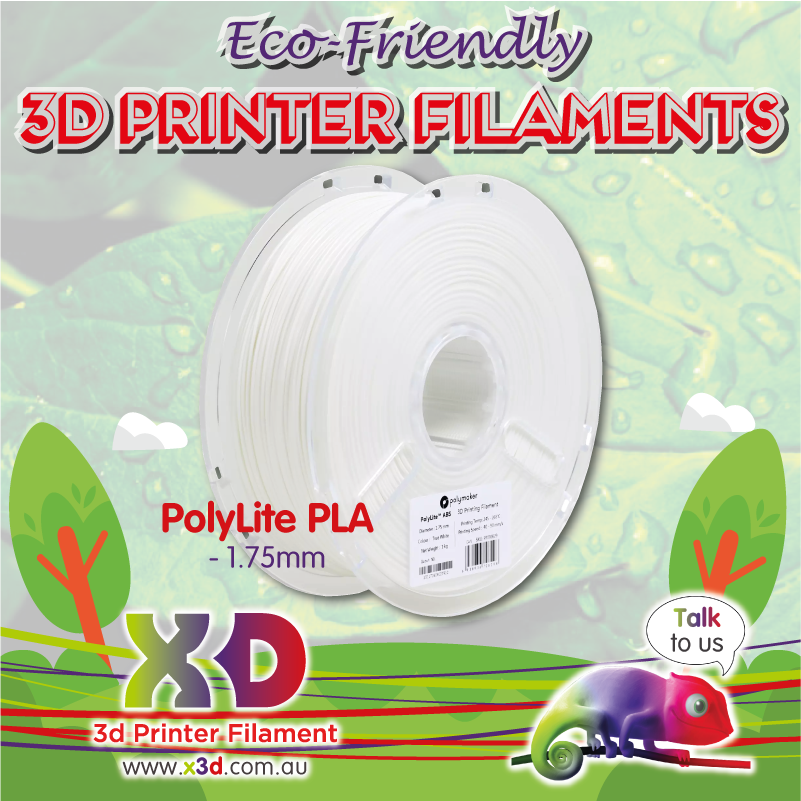


So you’ve already been practicing environmentally friendly 3D printing methods that we have discussed in a previous blog post. Despite all the changes you’ve made, you may be wondering about the fumes that your filaments have been emitting. You may have noticed this in some high-strength and performance engineering materials such as ABS, Polycarbonate, and some Nylon filaments. If this is worrisome for you or you have a particularly sensitive sense of smell, there are eco-friendly alternatives to regular 3D printer filaments. Read our blog post to learn more.
PLA
Regular PLA is typically eco-friendly since it is made of renewable organic resources such as cornstarch from maize and dextrose from sugarcane. It is also biodegradable with a decomposition time of 3 – 6 months depending on the decomposition methods. However, it has to be disposed of in an industrial composting facility or home compost bin as leaving it in a landfill will do nothing.
Since it is made of organic material, it has a low emission of non-toxic fumes during 3D printing. This makes it safe for use in homes and schools.
The trade-off when using PLA is that it creates prints that are brittle and low resistance against impact and temperature. It is only good for visual prints, rapid prototyping, and anything that doesn’t require excellent mechanical strength. Luckily, there are new reinforced PLA filaments that are formulated to rival and even exceed ABS.
X3D Pro PLA

Volcano PLA

PolyLite PLA

PolyMax PLA

Eco-Friendly PLA Alternative: rPLA by Filamentive (coming soon)

Cornstarch is hard to grow and requires plenty of water, making it an environmental concern. rPLA by Filamentive is produced from factory waste streams instead of virgin pellets, therefore making it more environmentally-friendly.
ABS
ABS is by no means environmentally friendly. It is one of the most harmful 3D printer filaments since it doesn’t decompose completely and emits toxic fumes. However, many people still use them due to their affordable price, lightweight nature, and excellent mechanical properties. If it is imperative that you use ABS for a project, look for an eco-friendlier alternative, such as the reinforced PLA filaments above or Filamentive’s rABS, which is only made up of 60% ABS.
Eco-Friendly ABS Alternative: rABS by Filamentive (coming soon)

PETG
PETG is already considered as an environmentally friendly 3D printer filament since it is recyclable and food-safe. Since it is still made of plastic, it still has negative impacts on the environment. A great alternative is recycled PET filament, such as ONE PET from Filamentive.
ONE PET by Filamentive (coming soon)

ONE PET is completely made up of recycled consumer PET bottles. Its mechanical properties are just excellent as PETG with its elongation strain at break and tensile modulus and strength.
Polycarbonate
Polycarbonate filaments are the strongest 3D printer materials out there. However, it is harmful to your health and the environment as it emits Bisphenol A (BPA). To give yourself peace of mind while also helping the environment, use this eco-friendlier PC blend by Filamentive.
bioPC by Filamentive (coming soon)

bioPC by Filamentive is made of a copolyester material that displays the same high resistance to heat, impact, and chemical as Polycarbonate.
Be Kind to the Planet and Switch to these Eco-Friendly Filaments Today!
Never have to worry about the negative impact of 3D printing on your health or the environment with these eco-friendly 3D printer filaments. If you want to order any of the up-and-coming Filamentive filaments above, keep your eyes peeled for updates on our official Facebook page or Instagram page. You can also add yourself to our waitlist by emailing x3d@x3d.com.au.

